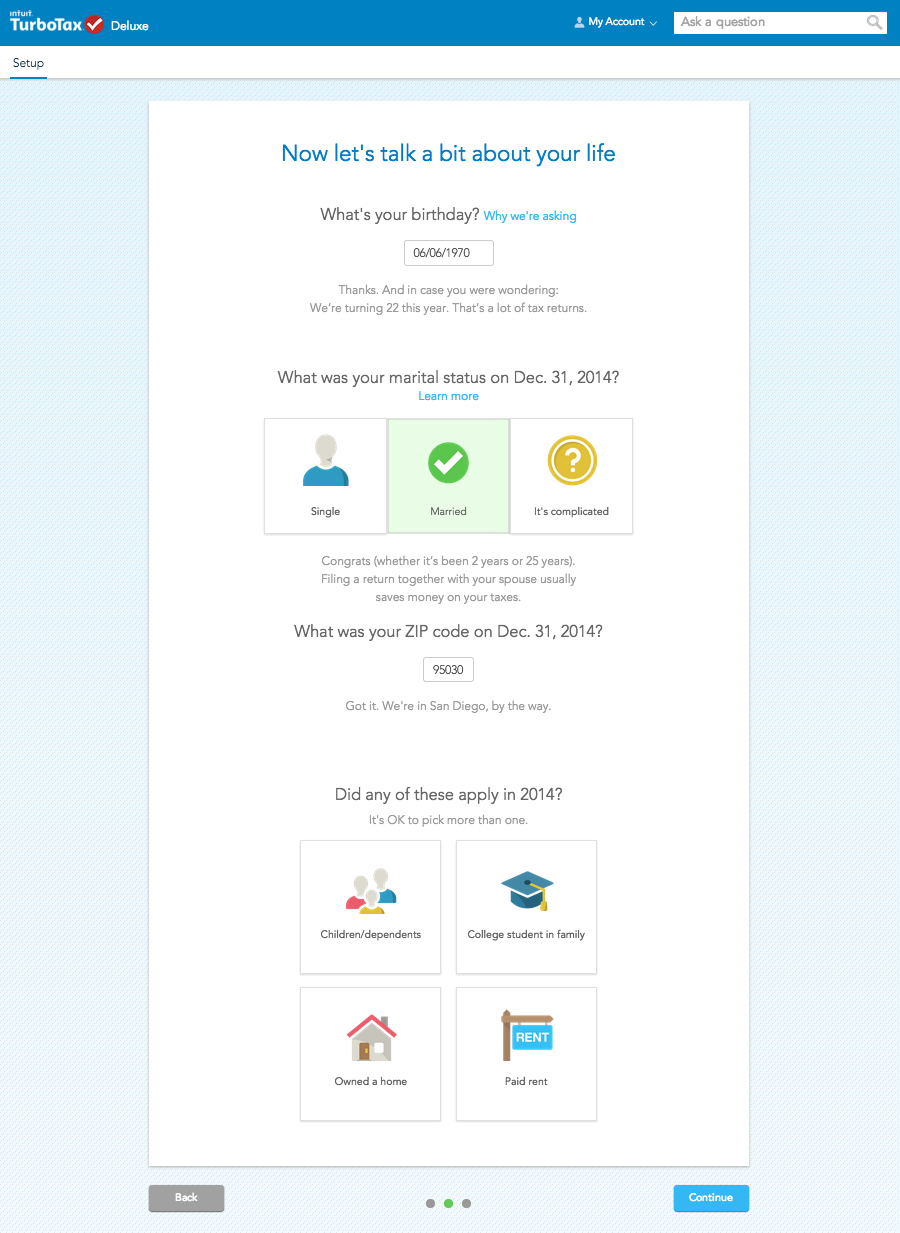Years ago I loaded all my belongings into my tiny sports car and prepared to head for Los Angeles. A close friend asked me why I wanted to l leave Northern California, where I had a good job, good friends, and a nice place to live.
“It’s all too comfortable here,” I told him. “In L.A., I’ll start a new adventure, I’ll meet new people, with new ideas and new opportunities.”
And I did. Shortly after settling in Los Angeles I launched a career in journalism, followed by an exciting new career in UX design. But to be honest, it was a terrifying move.
It’s scary to abandon the safety of what already works. And that’s true for many UX writers and designers. We tend to produce in ruts because ruts are comfortable. But we need aspirational thinking and new ways of doing things to create delightful experiences that build lasting relationships with our customers—and these things are seldom born out of comfort.
As a content strategist for TurboTax, I’m convinced that if we don’t offer something that connects with people on an emotional level our competitors will. Products that appeal to an emotional need win every time. That’s why we need the courage to harness emotion in all our designs.
So how do we find the courage to let go of the status quo and start doing things that make us uncomfortable, things that could lead to emotional design? Provocation is a good place to start. True provocation—the kind that gets us thinking differently about a problem or a goal—lies beyond the resources at hand, like colleagues and other internal avenues for unpacking customer insights. You need to bring in people who can offer a completely different perspective.
Start with Reflection
To start sourcing your external provocateur, take an honest look at what makes your product, website, or service unique: Is it deep and immersive? Light and entertaining? Legal and official? Then brainstorm with your team by asking: What kinds of experiences are analogous to ours? Think outside of your industry, but don’t go too far. You’re probably not going to end up asking the creator of custom surf boards to provoke your team of financial app designers into thinking differently. But the designer of an online healthcare portal might seek provocation from someone in the homeowner services industry. The goal is a list of analogies that both sit on the fringes of your world and contain a mix of similarities. It’s a fun and enlightening exercise that will set you up to identify the right provocateur. The hard part can be the work of narrowing the analogies down to two or three.
We tend to produce in ruts because ruts are comfortable
Once you land on a couple good analogies for your product or service, do some research on who you can hire from those industries to come in and work with your team and provide a different perspective. Go broad. Make a list for each, and then filter out unavailable and less-than-competent choices. A best-selling novelist may have amazing things to share about the art of storytelling, but is probably not equipped to engage your team in a corporate setting on a weeks-long project that is expected to produce concrete deliverables.
Our TurboTax content design team struggled to come up with analogies for a once-a-year, tax-prep experience that takes customers deep into a complex and immersive task. After brainstorming, narrative video games, such as Skyrim or Bioshock, emerged as one strong and provocative analogy. They’re essentially based on tasks and chores, but people love playing them. And the writers and designers of games like these have succeeded in creating relationships with their customers that last for years.
Image from BioShock
So the TurboTax team chose a narrative video game writer who worked on a long list of successful games, but had also worked with several large companies to provoke their design teams with her unique take on “player” and “non-player” characters. The game characters, she said, can’t get in the way of the player’s expectation of how the game, and the game story, is going to go. And the same can be true for TurboTax.
Appeal to Emotions to Get Buy-In
You’ll need approval and a budget to hire someone from outside your industry to come in and provoke your team. Making an emotional connection with your leadership team is key in making the case for emotion in design—and for your “project provocateur.”
At Intuit, we focus on solving customer problems. We have found that creating a proposal that starts with a hypothesis to make the case for change, followed by an analysis of the current experience, can resonate. Tell your leadership team a story about a customer facing a painful problem, a problem you can solve.
I made a case for emotion as we worked to re-imagine the voice of TurboTax, encouraging our vice president of product design to think of the customer who lives paycheck-to-paycheck. I asked him to envision a parent talking about taking their kids on a trip to Disney World. Then I made the case for emotion: to stop talking about taxes and start talking about Disney World, about how to help our customers realize their dreams. He got it. It meant something. The opportunity to connect with people was clear.
A short list of possible provocateurs should be presented next, including the reasons why they could help your design team change the game. Make sure you’re clear that the goal is provocation, not instruction. You’re not looking for someone to come in and tell everyone what to do.
You may want to consider two or three different tracks for your provocation project. The TurboTax content team pitched storytelling pros from a spectrum of industries, not just video games. We also ended up engaging a top ad agency as part of the project, which yielded some very exciting new thinking around the type of character we could portray with our voice and tone.
Bring Provocateurs into Your House
Once you’ve settled on one or two people to come in and rock your world, set clear expectations. This should not be treated like a consultation. It’s an immersive experience for you and your team. That means your provocateur should spend most of their time working with your designers in your design space.
Before you start, have your provocateur submit a proposal, but don’t get too hung up on the details. Free-flowing inspiration and ideation is essential. Remember, they are coming from outside your world to bring you and your team the gift of new insights and fresh ways of thinking about your customers. The less structure you impose on them the better.
Set up blocks of time so that people can flex in and out, and try to include a group of folks from the end-to-end experience. When I did this for the TurboTax content team, I asked key people from marketing and PR to participate. They were thrilled. Not only did they add to the diversity of ideas and perspectives, they evangelized our new thinking to their respective teams.
So What Can You Expect?
A new strategy for connecting with your customers could be your ultimate deliverable. At the very least, you’ll probably have a plan to experiment. Here are some things to consider as you keep your eyes on the prize of emotion:
- If you haven’t done it already with your provocateur, establish who your product character needs to become, and what it will take to bring this new character to life.
- Craft a new set of principles. Push yourselves to make them aspirational. “Keep it simple” is a solid principle, but you’re probably already doing it. And it’s not going to help you connect emotionally with your customers.
- Test-drive your new character and/or principles on some screens or flows from your current product experience. This will help you get in a groove, while creating a powerful tool to help others see the possibilities. If your examples make some people uncomfortable, that’s good!
- As you consider redesign work based on your new strategy, break it up into “just dos” and “experiments needed.”
- Create a presentation that includes your challenge and the story of how you got to your new strategy, and then share it with the rest of your org. “It’s a journey,” I like to say. “We’re sure we need to change the game, and this is what we’re doing about it right now. That doesn’t mean we won’t flex and refine this along the way.”
Again, appeal to emotions. Include examples that pull on heartstrings to drive home the power of your new strategy. Put your customers at the center of what you’re proposing, and remind everyone that you won’t create a lasting relationship with your customers unless you start doing things that make you uncomfortable.










